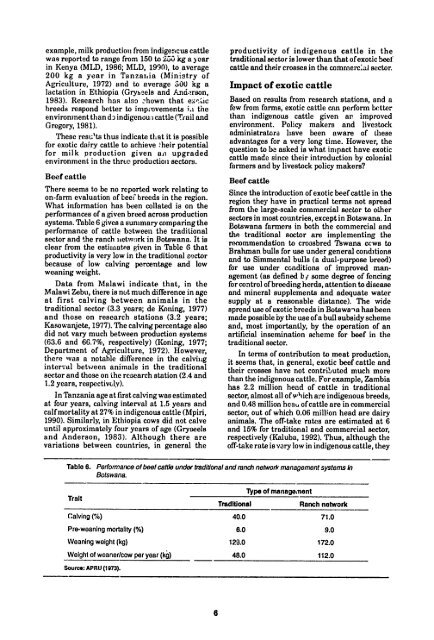aistand south~ern afrkca - (PDF, 101 mb) - USAID
aistand south~ern afrkca - (PDF, 101 mb) - USAID
aistand south~ern afrkca - (PDF, 101 mb) - USAID
Create successful ePaper yourself
Turn your PDF publications into a flip-book with our unique Google optimized e-Paper software.
example, milk production fromindigeacus cattle<br />
was reported to range from 150 to 25 kg a year<br />
in Kenya (MLD, 1986; MLD, 1990), to average<br />
200 kg a year in Tanzania (Ministry of<br />
Agriculture, 1972) and to average 300 kg a<br />
lactation in Ethiopia (Grybeels and And-irson,<br />
1983). Research has also 2hown that ex'.ic<br />
breeds respond better to impiovements i.i the<br />
environmentthandindigenoujcattle(Trailand<br />
Gregory, 1981).<br />
These resu'ts thus indicate that it is possible<br />
for exotic dairy cattle to achieve their potential<br />
for milk production given aii upgraded<br />
environment in the threo production sectors.<br />
Beef cattle<br />
There seems to be no reported work relating to<br />
on-farm evaluation of beef breeds in the region.<br />
What information has been collated is on the<br />
performances of a given breed across production<br />
systems. Table 6 gives a summary comparing the<br />
performance of cattle between the traditional<br />
sector and the ranch network in Botswana. It is<br />
clear from the estimates Fiven in Table 6 that<br />
productivity is very low in the traditional cector<br />
because of low calving percentage and low<br />
weaning weight.<br />
Data from Malawi indicate that, in the<br />
Malawi Zebu, there is not much difference in age<br />
at first calving between animals in the<br />
traditional sector (3.3 years; de Koning, 1977)<br />
and those on research stations (3.2 years;<br />
Kasowanjete, 1977). The calving percentage also<br />
did not vary much between production systems<br />
(63.6 and 66.7%, respectively) (Koning, 1977;<br />
Department of Agriculture, 1972). However,<br />
there was a notable difference in the calving<br />
interval between animals in the traditional<br />
sector and those on the rcsearch station (2.4 and<br />
1.2 years, respectivly).<br />
In Tanzania age at first calving was estimated<br />
at four years, calving interval at 1.5 years and<br />
calf mortality at 27% in indigenous cattle (Mpiri,<br />
1990). Similarly, in Ethiopia cows did not calve<br />
until approximately four years of age (Gryseels<br />
and Anderson, 1983). Although there are<br />
variations between countries, in general the<br />
productivity of indigenous cattle in the<br />
traditional sector is lower than that ofexotic beef<br />
cattle and their crosses in the commerc:al sector.<br />
Impact of exotic cattle<br />
Based on results from research stations, and a<br />
few from farms, exotic cattle can perform better<br />
than indigenous cattle given ar improved<br />
environment. Policy makers and livestock<br />
administrateor have been aware of these<br />
advantges for a very long time. However, the<br />
question to be asked is what impact have exotic<br />
cattle made since their introduction by colonial<br />
farmers and by livestock policy makers?<br />
Beef cattle<br />
Since the introduction ofexotic beef cattle in the<br />
region they have in practical terms not spread<br />
from the large-scale commercial sector to other<br />
sectors in most countries, except in Botswana. In<br />
Botswana farmers in both the commercial and<br />
the traditional sector are implementing the<br />
recommendation to croesbred Tswana cws to<br />
Brahman blls for use under general conditions<br />
and to Simmental bulls (a dual-purpose breed)<br />
for use under conditions of improved management<br />
(as defined b I some degree of fencing<br />
for control of breeding herds, attention to disease<br />
and mineral supplements and adequate water<br />
supply at a reasonable distance). The wide<br />
spread use ofexotic breeds in Botswa-a has been<br />
made possible by the use ofa bull subsidy scheme<br />
and, most importantly, by the operation of an<br />
artificial insemination scheme for beef in the<br />
traditional sector.<br />
In terms of contribution to meat production,<br />
it seems that, in general, exotic beef cattle and<br />
their crosses have riot contributed much more<br />
than the indigenous cattle. For example, Za<strong>mb</strong>ia<br />
has 2.2 million head of cattle in traditional<br />
sector, almost all ofwiich are indigenous breeds,<br />
and 0.48 million heau ofcattle are in commercial<br />
sector, out of which 0.06 million head are dairy<br />
animals. The off-take rates are estimated at 6<br />
and 15% for traditional and commercial sector,<br />
respectively (Kaluba, 1992). Thus, although the<br />
off-take rate is very low in indigenous cattle, they<br />
Table 6. Performance of beef cattle under traditional and ranch netwoikmanagementsystems in<br />
Botswana.<br />
Trait<br />
Type of management<br />
Traditional Ranch network<br />
Calving (%) 40.0 71.0<br />
Pro-weaning mortality (%) 6.0 9.0<br />
Weaning weight (kg) 129.0 172.0<br />
Weight of weaner/cow per year (kg) 48.0 112.0<br />
Source: APRU (1973).<br />
6

















